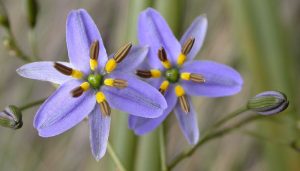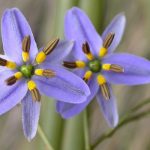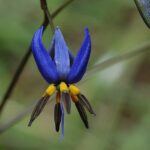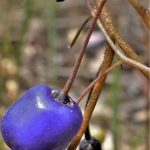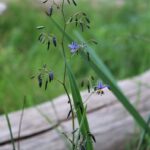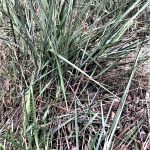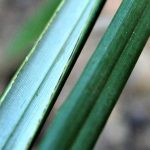This image by DavidFrancis34, has licence: CC BY-SA 2.0 <https://creativecommons.org/licenses/by-sa/2.0/>
Gardening with Indigenous Plants
Indigenous Plant Use
Identification & Control of Common Weeds
| Botanical Name: | Dianella revoluta var. revoluta 3 synonyms: Dianella admixta, Dianella revoluta f. denticulata, Dianella revoluta f. elongata |
| Common Name: | black-anther flax-lily, blue-flax lily, blueberry lily, spreading flaxlily |
| Sold As: | 140 mm pot ($5.00) |
| Plant Type(s): | Lily, Ground Cover (up to 30 cm), Bird Attracting, Butterfly Attracting, Insect Attracting, Cottage, Indigenous Plant Use |
| Indigenous Plant Use: | Dark blue or purple berries edible when ripe.CAUTION: Many plants are poisonous if not collected and prepared properly! |
| Growing Conditions: | Full Sun, Partial Shade
Clay, Dry, Well Drained |
| Size (HxW): | 0.3-0.8 m x 0.5-1.5 m |
| Foliage: | Narrow erect dark green strap leaves, paler on lower surface, 15-65 cm x 0.5-1.2 cm, sheathed at base. Sheaths reddish. Leaf margins rolled under, finely toothed, midrib smooth. |
| Flowers: | Blue to violet. Anther brown to black, stalk swellings yellow, August-May. Open, conical-shaped flowerhead on a stalk taller than leaves, petals spreading to curved back. Berry small, shiny, dark blue. |
| General Comments: | Dense to open tufting perennial spreading by branched underground stems. Birds like the berries. Useful small tufting plants for drier gardens, cottage gardens and rockeries. Grows well under established trees. Likes to go in well drained drier clay soils, widespread throughout many plant communities. Snow and frost tolerant. |
 Further Information: |
This image by DavidFrancis34, has licence: CC BY-SA 2.0 <https://creativecommons.org/licenses/by-sa/2.0/>
This image by Friends of Chiltern Mt Pilot National Park, has licence: CC BY-NC-SA 2.0 <https://creativecommons.org/licenses/by-nc-sa/2.0/>
Close up of the leaves (caption)

